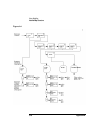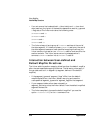
318 Glossary
Glossary
header string A string,
"!<arch>\n", which identifies a
file as an archive created by ar (\n
represents the newline character).
hiding a symbol Making a
symbol invisible to code outside the
module in which the symbol was
defined. Accomplished with the -h
linker option.
immediate binding By default,
the dynamic loader attempts to
bind all symbols in a shared
library when a program starts up
— known as "immediate binding."
Compare with "deferred binding."
implicit address dependency
Writing code that relies on the
linker to locate a symbol in a
particular location or in a
particular order in relation to
other symbols.
implicit loading Occurs when
the dynamic loader automatically
loads any required libraries when
a program starts execution.
Compare with "explicit" loading.
import stub A short code segment
generated by the linker for
external references to shared
library routines. See also export
stub.
import symbol An external
reference made from a library.
incomplete executable An
executable (a.out) file that uses
shared libraries. It is "incomplete"
because it does not actually
contain the shared library code
that it uses; instead, the shared
library code is attached when the
program runs. Compare with
"complete executable."
indirect addressing The process
of accessing a memory location
through a memory address that is
stored in memory or a register.
initializer An initialization
routine that is called when a
shared library is loaded or
unloaded.
intermediate code A
representation of object code that
is at a lower level than the source
code, but at a higher level than the
object code.
I-SOM Intermediate code-System
Object Module. Used during
profile-based optimizations and
level 4 optimization.
library A file containing object
code for subroutines and data that
can be used by programs.


















